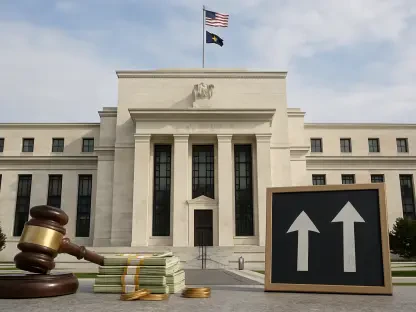In today’s financial landscape, the banking sector often finds itself shackled by regulations so stringent that they resemble the tight control historically imposed on public utilities, with the primary goal of ensuring stability at the expense of innovation. These rules, while well-intentioned, frequently fail to deliver the promised security, instead creating barriers to economic growth and limiting opportunities for both institutions and consumers. What if a different approach could yield better results? A recent deregulation success in New Hampshire’s electricity market offers a tantalizing glimpse of what might be possible. By reducing restrictive oversight and emphasizing choice, this reform has started to address systemic inefficiencies. This article delves into whether the banking industry could adopt a similar model, moving away from rigid mandates toward a framework that prioritizes individual judgment. Could such a shift unlock a more resilient and dynamic financial system, better equipped to meet modern challenges?
Drawing Parallels with Electricity Market Reforms
New Hampshire’s recent reform in the electricity sector provides a fascinating case study for potential change in banking. By allowing producers to operate outside traditional public utility regulations if they avoid connecting to the existing grid, the state has embraced a model that fosters flexibility and reduces bureaucratic constraints. This approach has shown early signs of success in tackling persistent issues, such as meeting consumer demand for power more effectively. Market forces, rather than top-down rules, are given room to drive solutions, creating a more responsive system. The analogy to banking is clear: just as electricity deregulation has prioritized choice, a parallel shift in the financial sector could enable institutions to better serve their clients by adapting to unique needs without the weight of overbearing oversight. This comparison raises the question of whether loosening the regulatory grip could similarly invigorate banking, allowing for innovation while still maintaining essential safeguards.
The implications of this utility reform extend beyond mere operational freedom. In New Hampshire, the move toward deregulation has encouraged competition among energy providers, potentially lowering costs and improving service quality for consumers. This outcome challenges the notion that heavy regulation is the only path to stability. Applying this lesson to banking, a less restrictive environment might similarly spur competition, driving financial institutions to offer more innovative products and better rates. The core idea is to shift the focus from enforcing a one-size-fits-all regulatory framework to creating space for market-driven solutions. While risks remain, as they do in any sector, the early results from the electricity market suggest that empowering individual players to make decisions based on their circumstances could yield benefits that rigid rules often fail to achieve. This perspective offers a compelling argument for testing a comparable model within the financial industry.
Critiquing the Current State of Banking Oversight
Banking regulation today often operates under a framework that mirrors the restrictive oversight of public utilities, with an intricate web of rules designed to prevent crises but frequently falling short of that goal. Over centuries, this prescriptive approach has consistently failed to ensure true stability, instead often shielding entrenched interests at the expense of consumers and emerging players. Regulators, despite their expertise, cannot foresee every potential risk, and their decisions sometimes hinder progress by prioritizing caution over opportunity. This system tends to stifle competition, as smaller or newer institutions struggle under the same burdensome requirements as larger, established ones. The result is a financial landscape where innovation takes a backseat to compliance, limiting the sector’s ability to evolve with changing economic needs and technological advancements.
Moreover, the persistent belief that the “perfect” set of regulations can be crafted to eliminate financial risk is fundamentally flawed. Such optimism overlooks the inherent nature of a free society, where taking calculated risks is a cornerstone of economic activity. Historical evidence suggests that no regulatory formula can fully account for human behavior or market unpredictability, much like past economic ideologies that promised ideal outcomes but delivered mixed results. In banking, this translates to a system that often protects the status quo rather than fostering a vibrant, adaptive environment. Consumers bear the cost through higher fees and fewer choices, while innovators find their ideas sidelined by red tape. Recognizing these shortcomings is the first step toward exploring alternative frameworks that might better balance safety with the need for growth and dynamism in the financial sector.
Advocating for a Shift to Individual Empowerment
Rather than continuing to impose detailed financial directives based on anticipated risks, a more effective regulatory approach could center on preventing fraud while granting individuals and institutions greater autonomy in their decision-making. Current government-backed mechanisms, such as federal deposit insurance, often produce unintended consequences by encouraging reckless behavior, as they shield stakeholders from the full impact of their choices. These safety nets, designed to instill confidence, frequently fail during crises, as seen in persistent bank runs where depositors rush to withdraw funds despite assurances. A reimagined system could prioritize accountability, allowing market dynamics to guide outcomes instead of relying on federal mandates. Such a change might foster a culture of responsibility, where both bankers and customers weigh risks more carefully.
This shift toward empowerment over control could redefine how the financial sector operates. By reducing the emphasis on protective measures that often fall short, regulators could focus on ensuring transparency and combating deceptive practices, leaving room for personal judgment to shape financial strategies. Imagine a banking environment where institutions are free to innovate without the constant threat of punitive oversight, provided they adhere to basic ethical standards. Consumers, in turn, would gain access to a wider array of services tailored to their needs, rather than being limited by standardized offerings shaped by regulatory constraints. While no system is without flaws, moving away from heavy-handed control toward a framework that trusts market participants to navigate their own paths could potentially lead to more sustainable and equitable outcomes in the long term.
Building on Existing Deregulation Models in Banking
A tangible starting point for reform already exists within the banking sector through the Community Bank Leverage Ratio (CBLR), a policy introduced several years ago as a lighter regulatory option. This framework permits smaller banks with assets under $10 billion to opt for simplified capital requirements by maintaining a higher capital ratio, a choice that around 40% of eligible institutions had adopted by last year. The CBLR demonstrates that deregulation, when thoughtfully implemented, can function without compromising safety, offering a less cumbersome alternative to traditional rules. It serves as evidence that providing options can encourage compliance while easing the burden on smaller players, allowing them to focus on serving their communities rather than navigating complex mandates. This success prompts the question of whether a broader application of such principles could reshape the industry.
Expanding on the CBLR, a more ambitious framework could further test the merits of deregulation by allowing any financial entity maintaining elevated capital ratios to operate with reduced regulatory oversight, provided they forgo federal protections like deposit insurance or access to certain lending programs. This optional system would create a proving ground for market-driven approaches, challenging the dominance of the current federal structure. If the existing model is indeed superior, few institutions would likely choose the alternative, posing little threat to policymakers. However, if the deregulated option gains traction, it could reveal the limitations of overregulation and pave the way for widespread reform. The success of limited deregulation models like the CBLR suggests that scaling up these efforts might unlock new levels of efficiency and innovation within banking, benefiting both providers and consumers.
Envisioning a Future of Financial Freedom
Taking inspiration from utility reforms, a bold proposal for banking could involve creating a system where entities adhering to stringent capital requirements are exempt from conventional operational regulations, provided they opt out of federal safety nets and lending programs. Existing banks might even establish affiliates to operate under this model, testing the waters of a less restricted environment. This framework would serve as a litmus test for the current regulatory approach—if the federal system truly offers the best path, most institutions would likely remain within it. Such a structure reflects a growing acknowledgment that heavy-handed oversight often fails to deliver on its promises, and a move toward individual empowerment through free enterprise could represent the next evolution of finance. This vision challenges long-held assumptions about the necessity of control.
Looking back, past efforts to balance regulation with innovation in banking revealed both the pitfalls of overreach and the potential of lighter approaches. The incremental success of policies like the CBLR highlighted that choice-driven systems could coexist with safety. As discussions around deregulation gained momentum, it became evident that fostering accountability over protection offered a viable path forward. The next steps involve policymakers considering pilot programs for expanded frameworks, ensuring that fraud prevention remains paramount while reducing unnecessary constraints. Financial institutions should prepare to adapt to a landscape where market judgment plays a larger role, and consumers must be educated on navigating risks in a less insulated environment. These actions, rooted in lessons from other sectors, could set the stage for a more responsive and robust banking system in the years ahead.









